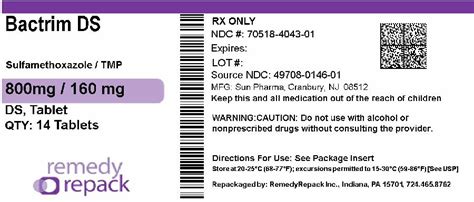Sulfamethoxazole/trimethoprim, commonly known as Bactrim, Septra, or cotrimoxazole, is a widely prescribed antibiotic used to treat various bacterial infections, including urinary tract infections (UTIs), bronchitis, and traveler’s diarrhea. While it is effective against a range of bacteria, its use comes with potential risks and side effects that patients should be aware of to manage their treatment safely and effectively.
Understanding Sulfamethoxazole/Trimethoprim
Sulfamethoxazole/trimethoprim belongs to the class of antibiotics known as sulfonamides. It works by inhibiting the growth and reproduction of bacteria, ultimately leading to their death. The combination of sulfamethoxazole and trimethoprim provides a synergistic effect, enhancing the antibiotic’s efficacy against a broader spectrum of bacterial infections.
Indications and Usage
This antibiotic is indicated for the treatment of various bacterial infections, including:
- Urinary Tract Infections (UTIs): Sulfamethoxazole/trimethoprim is commonly used to treat UTIs, especially those caused by E. coli, Klebsiella, and Enterobacter species.
- Respiratory Tract Infections: It is used for the treatment of acute exacerbations of chronic bronchitis and other respiratory infections caused by susceptible organisms.
- Traveler’s Diarrhea: For the treatment of traveler’s diarrhea due to enterotoxigenic E. coli.
Risk Management and Side Effects
While sulfamethoxazole/trimethoprim is generally well-tolerated, it can cause side effects ranging from mild to severe. It’s crucial for patients to be aware of these potential risks to manage them effectively:
- Gastrointestinal Symptoms: Nausea, vomiting, diarrhea, and abdominal pain are common side effects.
- Allergic Reactions: Rash, itching, and in severe cases, Stevens-Johnson syndrome or toxic epidermal necrolysis can occur.
- Kidney Problems: Patients with pre-existing kidney disease should use this medication with caution, as it can affect kidney function.
- Liver Damage: Rare cases of liver injury have been reported.
- Bone Marrow Suppression: This can lead to reduced blood cell counts, potentially causing anemia, low white blood cell count, or low platelet count.
- Hypersensitivity to Sulfonamides: Patients allergic to sulfonamides should avoid this medication.
- Hyperkalemia: High potassium levels in the blood, especially in patients with kidney disease.
Special Precautions
Certain groups of patients require special consideration when taking sulfamethoxazole/trimethoprim:
- Pregnancy and Breastfeeding: The use of sulfamethoxazole/trimethoprim during pregnancy, especially near term, and in breastfeeding mothers requires careful evaluation due to the potential risks of kernicterus in newborns and the displacement of bilirubin.
- Pediatric Patients: Dosage adjustments are necessary for children, and it should be used with caution due to the potential for kernicterus in newborns.
- Geriatric Patients: Elderly patients may require dosage adjustments due to reduced renal function.
Interactions with Other Medications
Sulfamethoxazole/trimethoprim can interact with various medications, either enhancing their effects or increasing the risk of side effects. Notable interactions include:
- Warfarin: Increased risk of bleeding.
- Phenytoin: Increased risk of phenytoin toxicity.
- Methotrexate: Increased risk of methotrexate toxicity.
Managing Risks Effectively
To manage the risks associated with sulfamethoxazole/trimethoprim effectively, patients should:
- Follow Prescriptions Closely: Adhere to the prescribed dosage and duration of treatment.
- Monitor for Side Effects: Be aware of potential side effects and report them to a healthcare provider promptly.
- Hydrate: Adequate hydration helps prevent kidney stones and reduces the concentration of the drug in the urine, potentially decreasing the risk of crystalluria.
- Regular Blood Tests: For patients on long-term therapy, regular blood tests can help monitor for adverse effects on the blood, liver, and kidneys.
Conclusion
Sulfamethoxazole/trimethoprim is a valuable antibiotic for treating various bacterial infections. However, like all medications, it carries potential risks and side effects. By understanding these risks, being aware of the special precautions necessary for certain patient groups, and managing the treatment regimen carefully, patients can minimize adverse effects and maximize the benefits of this antibiotic.
It's imperative for healthcare providers to educate patients about the proper use of sulfamethoxazole/trimethoprim, including dosage, potential side effects, and the importance of completing the full treatment course as prescribed.
FAQs

What is sulfamethoxazole/trimethoprim used for?
+Sulfamethoxazole/trimethoprim is an antibiotic used to treat various bacterial infections, including urinary tract infections, bronchitis, and traveler's diarrhea.
Can I take sulfamethoxazole/trimethoprim if I am pregnant or breastfeeding?
+The use of sulfamethoxazole/trimethoprim during pregnancy, especially near term, and in breastfeeding mothers requires careful evaluation due to potential risks. Consult a healthcare provider before using this medication in these situations.
What are the common side effects of sulfamethoxazole/trimethoprim?
+By being informed and vigilant, patients can navigate the use of sulfamethoxazole/trimethoprim safely and effectively, benefiting from its therapeutic effects while minimizing its risks.



